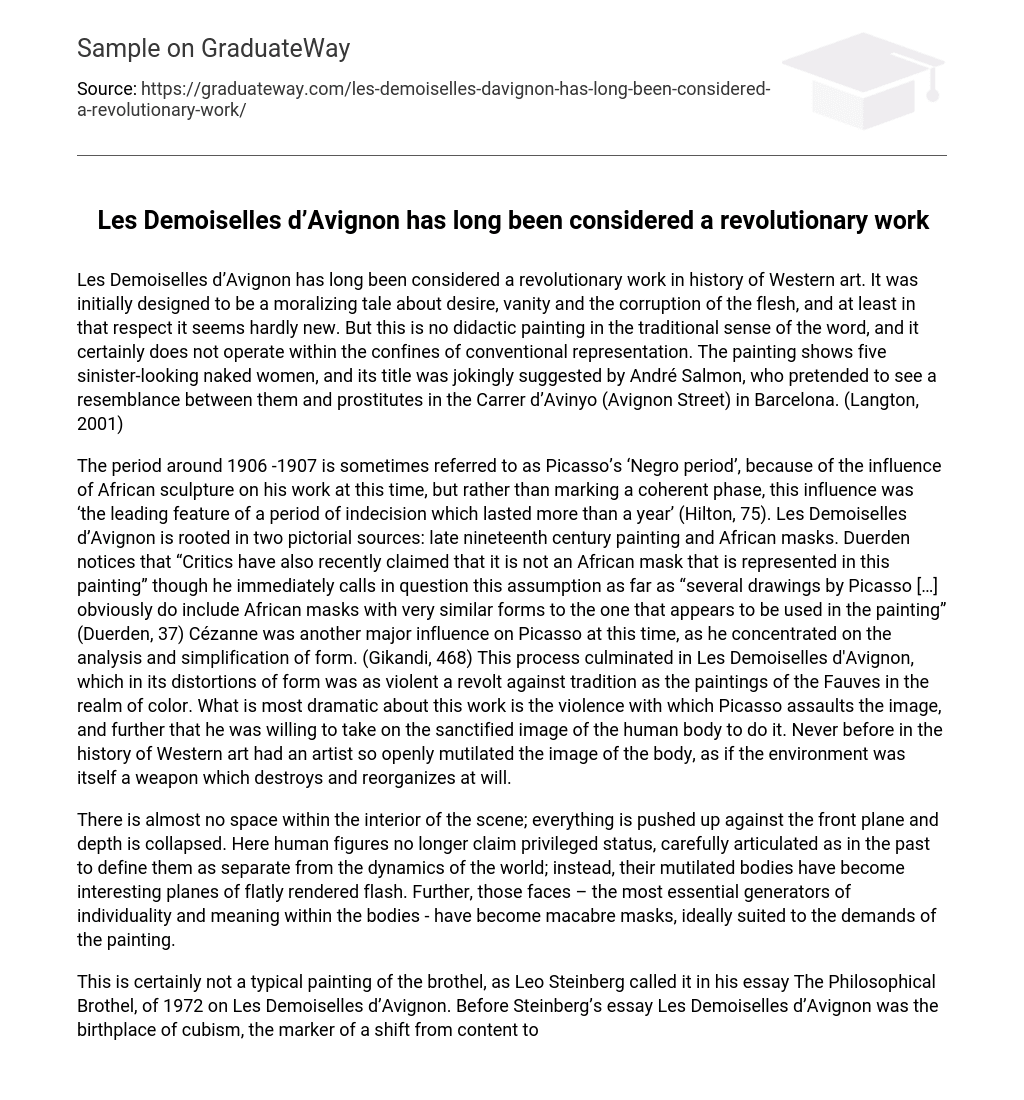Les Demoiselles d’Avignon has long been considered a revolutionary work in history of Western art. It was initially designed to be a moralizing tale about desire, vanity and the corruption of the flesh, and at least in that respect it seems hardly new. But this is no didactic painting in the traditional sense of the word, and it certainly does not operate within the confines of conventional representation. The painting shows five sinister-looking naked women, and its title was jokingly suggested by André Salmon, who pretended to see a resemblance between them and prostitutes in the Carrer d’Avinyo (Avignon Street) in Barcelona. (Langton, 2001)
The period around 1906 -1907 is sometimes referred to as Picasso’s ‘Negro period’, because of the influence of African sculpture on his work at this time, but rather than marking a coherent phase, this influence was ‘the leading feature of a period of indecision which lasted more than a year’ (Hilton, 75). Les Demoiselles d’Avignon is rooted in two pictorial sources: late nineteenth century painting and African masks. Duerden notices that “Critics have also recently claimed that it is not an African mask that is represented in this painting” though he immediately calls in question this assumption as far as “several drawings by Picasso […] obviously do include African masks with very similar forms to the one that appears to be used in the painting” (Duerden, 37) Cézanne was another major influence on Picasso at this time, as he concentrated on the analysis and simplification of form. (Gikandi, 468) This process culminated in Les Demoiselles d’Avignon, which in its distortions of form was as violent a revolt against tradition as the paintings of the Fauves in the realm of color. What is most dramatic about this work is the violence with which Picasso assaults the image, and further that he was willing to take on the sanctified image of the human body to do it. Never before in the history of Western art had an artist so openly mutilated the image of the body, as if the environment was itself a weapon which destroys and reorganizes at will.
There is almost no space within the interior of the scene; everything is pushed up against the front plane and depth is collapsed. Here human figures no longer claim privileged status, carefully articulated as in the past to define them as separate from the dynamics of the world; instead, their mutilated bodies have become interesting planes of flatly rendered flash. Further, those faces – the most essential generators of individuality and meaning within the bodies – have become macabre masks, ideally suited to the demands of the painting.
This is certainly not a typical painting of the brothel, as Leo Steinberg called it in his essay The Philosophical Brothel, of 1972 on Les Demoiselles d’Avignon. Before Steinberg’s essay Les Demoiselles d’Avignon was the birthplace of cubism, the marker of a shift from content to form in modern painting; after Steinberg’s essay, it has become the marker of a shift to a new kind of engagement with sexuality, one whose immediacy was unprecedented in the history of painting. (Florman, 769)
Picasso’s use of African masks as a pictorial source serves an important visual function in the painting, but it also reminds us how such images often carry other implicit connections to their age. In African masks Picasso saw the radical flattening of features and bold descriptive markings that corresponded rather well to his own predisposition for depicting forms, and it solved a tricky problem of dealing with face. Picasso saw such work as powerful imagery, ready to be used. In this way, artists such as Picasso paralleled many of the less articulated attitudes of Europe toward the African continent at the turn of the century – a source of raw material, cheap labor, and exotic subject matter, with little knowledge of the cultures that informed such work. (Green, 2001) This is not meant to be an indictment of such work; rather it helps explain how artists as individuals are often implicitly bound to their world, and their work is the carrier of those contradictions.
Picasso produced the painting which was, even for the few artist friends, including Matisse and Derain, who saw it, so ugly and shocking that the big canvas remained rolled up and hidden for several years in a private collection, making its public debut in 1916. It is now seen not only as a pivotal work in Picasso’s personal development but as the century’s principal milestone, a signpost pointing away from the conventions of the past. It revolted against Impressionism and ignored the decorative color experiments of the Fauves, embracing distortion as a source of expressive power and pointing towards what Braque was to call ‘the materialization of the new space’, which he and Picasso would formulate and explore in the movement called Cubism. (Langton, 2001)
Les Demoiselles d’Avignon seems to pose more questions than it answers, and it would take time to comprehend fully the repercussions of such departure from the norm. Yet it remains the most visible break through into twentieth-century art, and it started a dialogue that would eventually bring us to the present day.
Works Cited List
Duerden, Dennis. “The “Discovery” of the African Mask” Research in African Literatures 31.4, Winter 2000, pp. 29-47
Gikandi, Simon. “Picasso, Africa, and the Schemata of Difference” Modernism/modernity 10.3, September 2003, pp. 455-480
Green, Christopher. Picasso’s ‘Les Demoiselles D’Avignon’ New York: Cambridge University Press, 2001
Hilton, Timothy. Picasso. London: Thames and Hudson, 1985
Florman, L. “The Difference Experience Makes in “The Philosophical Brothel” The Art Bulletin 85.4, December 2003, p. 769-83
Langton, John “Picasso, Pablo” The Oxford Companion to Western Art. Ed. Hugh Brigstocke. Oxford University Press, 2001





